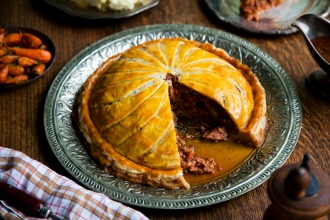When the nights are dark and the weather is cold there is nothing more comforting than coming home to a delicious, hearty home-cooked pie. Served with potatoes and seasonal vegetables, a pie makes for a tasty mid-week treat.
They’re also a great way of using up leftover vegetables, as well as cheaper cuts of meat such as oxtail off the bone or skirt steak. These cuts tend to be the ones with more flavour and just melt in the mouth when braised slowly.
Whilst homemade pies aren’t difficult to make, there are a number of common mistakes which can result in a soggy pastry or uneven filling. These pitfalls are easily avoided though and our hints and tips will help take your pie to the next level.
CHOOSE THE RIGHT PASTRY OR TOPPING
There are a number of different pastry options, from short-crust to puff and home-made to pre-made.
The type of pastry to use does depend on your filling of choice. For a hearty beef pie, shortcrust pastry is best as it is able to compete with the stronger flavours of the meat. For more delicate flavours, such as fish or fruit, a light and airy puff-pastry works better.
A pastry shell or just the top?
When choosing to create a pie with a bottom and sides rather than just the pastry top, it is best to use shortcrust pastry. Puff pastry has a tendency to go soggy and is therefore not recommended to use as the base.
If you do prefer a flakier top for your beef pie, you could combine the two and use shortcrust for the sides and the bottom and puff pastry on the top. This gives the pie a more professional touch and also gives it a more interesting texture.
If you are using shortcrust pastry don’t forget to blind bake it before adding the filling. Shortcrust pastry tends to take longer to cook than the filling therefore it needs this head start to avoid the pastry being too soggy, or the filling overcooked.
It is also best to use a metal pie dish as it helps to ensure the bottom of the pastry crisp up nicely. A glass dish is also a great option as it takes it time to heat and cooks evenly.
Alternatives to pastry
If you don’t want to use pastry, why not top the pie with sliced or mash potatoes. You could even try a traditional suet topped pie. Suet works well with classic pies such as Steak and Kidney and is steamed rather than cooked. Just ensure you are using the best beef suet and mix with flour and salt and wrap the filled pie before steaming in a pan of boiling water.
CREATE THE RIGHT MIX OF FILLING
There are some many choices for the filling of a pie. From traditional steak and ale or steak and kidney, to a more modern beef and blue cheese.
Whatever your choice of filling though, you need to ensure there is a good ratio of sauce to solids. An ideal ratio would be:
- 50% liquid
- 30% meat
- 20% other ingredients e.g. vegetables
When choosing your cut of meat it needs to be one that cooks slowly to ensure a tender, melt in the mouth texture and maximum flavour. Some good examples would be Oxtail off the bone or skirt steak. The meat should then be cut into large chunks for the indulgent among us.
Choose your vegetables
Most pie recipes will call for vegetables. Onions are a must and should be browned first, rather than just softened, to add maximum flavour. Carrots are also a classic addition but can become too soft if cooking for a longer time. Mushrooms also work well with beef however it is worth noting that their juices do add more liquid to the gravy, resulting in it becoming thinner and watery. If you are using mushrooms in your pie just remember to compensate with additional thickener.
Add extra flavourings
Thyme and bay leaf are the classic herb choices with thyme in particular complimenting beef well. Don’t be afraid though to experiment! For example – to add flavourings to a traditional steak and ale pie consider adding a little dark sugar, and a dash of vinegar, or even a dollop of brown sauce or cocoa powder!
Cool the filling
One of the most common mistakes when making pies is adding the filling to the pastry before it has cooled. If you do this the base of your pie will absorb moisture from the hot filling and wont cook through, resulting in a soggy pastry bottom. Remember to cool your mixture fully before you add it to your pastry.
THICKEN THE GRAVY
The final ingredient to a perfect pie is ensuring the right thickness of the gravy with the help of thickening agents. Be careful though as too much thickening agent and it can become rubbery in taste, but not enough and the pie becomes runny with that dreaded soggy bottom.
The thickening agents are starches which, when heated, bond with water molecules and enlarge like a balloon – absorbing the water around it.
The three common thickening agents include:
- Wheat flour
- Cornflour
- Tapioca
Wheat flour
This is the most common however it can complicate the thickening process as if you just mix water with wheat flour it forms gluten which can cause the sauce to get lumpy. To avoid this, it’s best to create a roux first (mix the flour with oil) before adding it to the liquid.
Cornflour
This thickens quicker than wheat flour and is almost flavourless. When using this to thicken gravy it’s best to mix it with a bit of cold water first and then whisk it into the hot liquid.
Tapioca
This is a good choice for pie fillings as it thickens at a lower temperature, which works well with our slow cooked fillings. If using tapioca bear in mind that instant Tapioca doesn’t always dissolve completely and can therefore leave small gelatinous lumps. To avoid this use Tapioca starch which is much finer.
FINISHING YOUR PIE
Before you put your pie into the oven there are just a few finishing tips to ensure you achieve perfection!
- Don’t forget to seal your pie lid with egg wash, and poke a few holes in the top (if you are not using a ceramic pie bird) to let the steam escape.
- Glaze the top of the pie with more egg wash to give it a golden finish.
- Finally, don’t forget to pre-heat the oven before putting the pie in. if you don’t the pastry will melt


